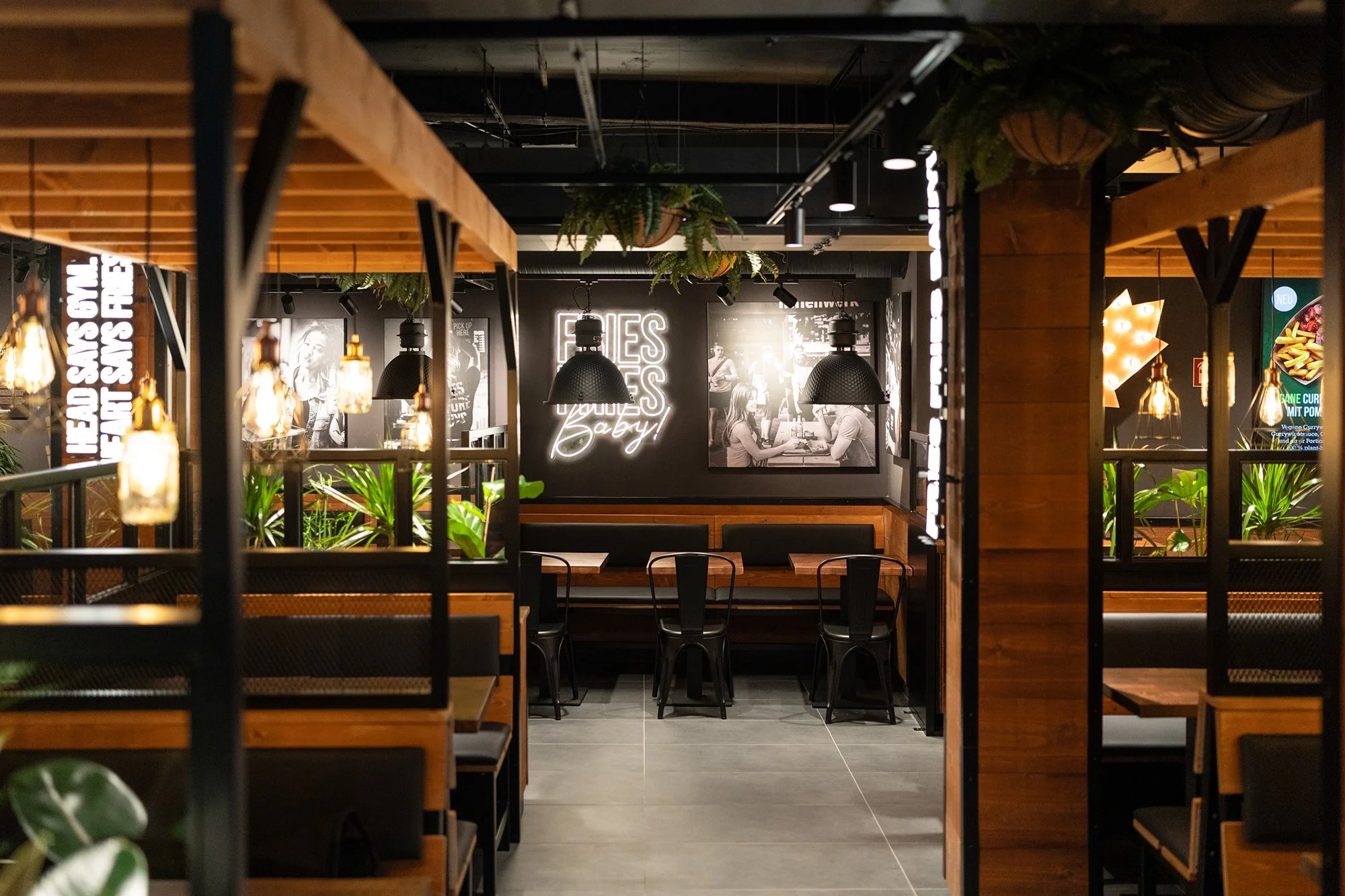How to Choose Materials for Commercial Interiors
March 2025
CONTRIBUTING EXPERTS:
JULIE MILLER, RESOURCE LIBRARIAN | EIS NORTH AMERICA
DAVID DAI, TECHNICAL PROCESS SUPERVISOR | EIS CHINA
The interior design materials you select for your restaurant or retail space can have a huge impact. The proper materials can further your brand identity and help create an atmosphere that keeps people coming back.
Good commercial interior design considers how it makes customers feel, and the materials chosen play a big role.
“The right choice of materials not only enhances the aesthetics and functionality of the space but also enhances the comfort and satisfaction of customers,” said David Dai, a technical process supervisor for Elkay Interior Systems (EIS). “It can enhance the overall attractiveness of the commercial space.”
Natural materials, for example, are proven to be calming and grounding. They are perfect for creating a customer experience in restaurants and retail spaces where guests want to stay for a while, not just get through.
What to Consider When Choosing Interior Design Materials
Durability
Peet’s Coffee | Nanjing, China
“Durability is the most important thing to consider,” said Julie Miller, Resource Librarian for EIS. “We have a lot of standards as far as how we want our materials to perform. You’re trying to make something that will last 7-10 years or beyond.”
The reason durability is so important to commercial interior design is that commercial millwork and casegoods get a lot of use. They need to hold up under a lot of bumping, scraping, sitting, and more. Materials that are worn or broken negatively impact the customer experience.
Selecting higher-quality material may cost more upfront, but it won’t have to be replaced as quickly as lower-cost alternatives.
Durability and sustainability drive innovations among manufacturers. Opting for durable and sustainable materials will not hamper your ability to be creative or aesthetically pleasing.
“A lot of new products in the market are getting better at mimicking luxury materials while maintaining sustainability needs,” Miller said. “And coating materials are getting better to the point where they can still feel like fabric, not like film.”
Laminates
Reece Bath and Kitchen | Spring, Texas, USA
You will most likely deal with laminates for things like service counters, product displays, and cabinetry. While all laminates come with a protective wear layer, the thickness can differ.
For wainscoting or wall protection, look at compact laminate, which is thick. A half-inch of compact laminate can be load-bearing and provides structural support for millwork, like cabinetry, product displays, or a retail kiosk.
A new type of laminate from a company called Fenix has proven popular in Europe and has now become readily available in the US. Standard decorative laminates use a kraft phenolic backing, decorative paper layer, and PVC coating. Fenix has acrylic embedded in the color and wear layers of the product. This allows any minor dings or scratches to be repairable by a simple heating process. Additionally, all Fenix products have a soft-touch surface that is excellent with anti-fingerprint technology.
“We specify Fenix for a couple of new clients with modern aesthetics,” Miller said. “It has a great look and is so durable.”
Edge banding is another method to protect your millwork, countertops, and tabletops. Edge banding is a thin strip made from PVC that sticks to the edge of your laminate to protect it from scrapes and scratches.
There are many options for matching edge banding to your laminate. It doesn’t take away from the look of your interior and protects it from wear and tear.
Quartz is a common material for countertops, tabletops, and wall coverings in restaurants and retail stores, but with worker safety concerns in the quartz manufacturing industry, businesses are turning to solid surface options like Corian.
Solid surface can look great and be durable, but not all solid surface options perform the same. Some options contain polyester, which can look less expensive and is more brittle, leading to cracks.
When painting casegoods and furniture, choose powder coating over wet paint. Powder coating gives materials more resistance to cracking because it’s chemically baked at high temperatures. Wet paint is not commercially durable, according to Miller.
Upholstery
Hans im Gluck | Vienna, Austria
With upholstery, the durability can be rated using the Wyzenbeek double rub scale in America and the Martindale scale in Europe.
With the Wyzenbeek test, a piece of cotton or wire is rubbed across the piece of fabric being tested. Going back and forth counts as one double rub. The Martindale test follows the same principle but uses a figure-8 pattern.
For restaurant commercial use, you should pick a fabric that can sustain 100,000 double rubs before showing any visual signs of wear and tear. For retail use, fabric that handles 60,000 double rubs should work.
Try to get warranties for your materials whenever possible as they protect you financially if your materials fail too soon.
Flooring
Ace + Tate | Berlin, Germany
According to Dai, for flooring, choose wear-resistant, non-slip materials, such as anti-slip tiles or epoxy resin floors. This applies to both restaurants and retail spaces.
“The ground should be easy to clean and maintain,” Dai said. “Avoid porous materials to prevent stain penetration.”
Cleanability
Especially in restaurants, make sure everything is bleach-cleanable. You want to be able to sanitize your surfaces easily and often for the health and safety of your guests and staff.
Vinyl or vinyl alternatives are coated, easy to clean, and are the most common upholstery type found in restaurants. If you want sustainable materials, there are several “clean” vinyl alternatives.
If you do not want vinyl or something that looks and feels like vinyl, there are other options. Some fabrics can be sprayed with a protective coating, and some upholstery options come with vinyl backing or another type of water-resistant barrier.
Installation Cost
When considering materials, you might try to find cost-effective options. One thing to consider, however, is how labor-intensive and expensive it may be to install the material.
A material that costs more upfront might save you money because it’s less expensive to install.
Can you create a tile look without needing an expensive ceramic tile installation? Or is the tile worth it because it will last longer in a high-traffic area than cheaper alternatives? These are good questions to ask your designer and your interior contractor.
A recent move toward modularity makes it easier to swap in new design elements without the need for artisan labor. Some elements, like wall paneling, are even being made to include magnets for easy removal and replacement.
Along with installation costs, you should be aware of where your materials are coming from. Long lead times might delay your interior remodeling project and interfere with profits.
What to Avoid
Avoid wet paint on casegoods and furniture whenever possible. It takes longer to dry, and it gets scraped off or scuffed more easily than powder coating paint.
A typical restaurant dining chair sees frequent use and gets spilled on a lot. Avoid upholstery that has no protective coating. It can get stained or torn too easily. Also, avoid upholstery that has ridges or bumps that can trap dirt and are hard to clean.
Tips for Restaurant Interiors
Service Areas
Frittenwerk | Flensburg, Germany
If you’re going to undertake a restaurant remodel, think of dining spaces in experiential terms. It’s more than dining table and chairs that customers expect. Restaurant decor matters.
“There’s a lot of research to show what customers expect in these spaces. They’re looking for experiences,” Miller said. “People are not looking for just any old table and chairs at a restaurant they can sit down at. They want to enjoy their time and feel like they are experiencing something unique.”
The food delivery and takeout brand Wonder is an example of a brand that created a positive guest experience.
“Their interiors are branded, fun, sophisticated, with a modern and fresh color palette,” Miller said. “They’ve done a great job picking materials that are durable and meet their aesthetic needs.”
Aesthetics are always changing and coming back, so restaurant owners need to stay on top of trends. Currently, there is a push toward natural, 70s-style elements like rattan, and cane and cork, natural renewable resources.
“In recent years, there hasn’t been a lot of change in trends. Instead, brands have been building on the trends that emerged a couple of years ago,” Miller said. “That means clean simple lines and natural materials. What has changed is how those materials are being used.”
Miller also believes sustainable choices are the future of restaurant interior design.
Kitchens
Dai said kitchen equipment and fixtures need to be easy to clean and resistant to high temperatures and corrosion. That’s why food-grade stainless steel is the preferred material.
Dai added that the kitchen floors and wall coverings need to be fireproof and non-slip for safety reasons.
Tips for Retail Store Interiors
Ferguson | Newport News, Virginia
Like restaurants, retail space owners should consider how their interior contributes to customer satisfaction. Set yourself apart by providing a unique shopping experience.
The big difference is that a retail store interior offers more freedom of design. Not every surface needs to be wiped down and sanitized consistently. Plus, many of the design elements don’t face the same level of heavy use. Therefore, they don’t need to meet the high durability standards of restaurant materials.
Retail displays typically don’t receive as much wear-and-tear as restaurant dining tables, for example.
“The color palette and textures can come into play a little bit more,” Miller said. “There are more opportunities for high-end work.”
With more freedom, though, comes a little more danger. While you can push for new and innovative elements, you want to make sure how you use your materials doesn’t violate the warranty. And while you may want to experiment, make sure you’re not picking colors that clash or are distracting.
Summary
A commercial interior needs to balance pleasing aesthetics with durability and cleanability and the design elements need to create an enjoyable atmosphere. If they’re grimy or worn, it can negatively affect the customer experience.
Whether you’re building from scratch or undertaking a retail or restaurant renovation, expert help can make all the difference. The Brand Design Team at EIS has years of experience working with a wide range of successful brands. The team has helped create durable and exciting environments that can be scaled for multiple locations.
———
About Elkay Interior Systems
Elkay Interior Systems (EIS) is a tight-knit team of industry-leading designers, commercial-grade manufacturers, innovative engineers, resourceful project managers, and sourcing experts committed to every stage of your project by guaranteeing quality and reliability. We stand out from the crowd with our 40+ years of global experience in the restaurant, hospitality, retail, and education markets. We believe in simplifying the complicated.






